2020: When a Pandemic and Extreme Weather Collided | The Weather Channel – Articles from The Weather Channel
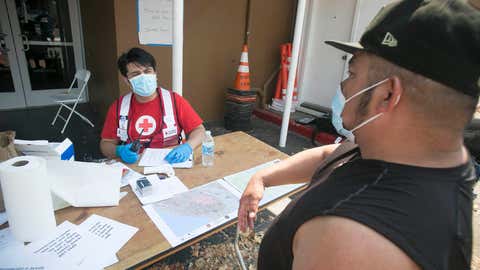
Omar Padilla is asked COVID-19 health screening questions by Red Cross volunteer Cristian Calvillo at a shelter at the Sonoma County Fairgrounds for those fleeing a wildfire in Santa Rosa, California.
(Dennis Drenner/American Red Cross)
- The pandemic took hold just as severe weather season kicked off.
- 2020 brought record fires, hurricanes and heat waves.
- Sheltering was especially complicated.
The coronavirus pandemic took hold in the United States in March, just as the annual severe weather season was kicking off.
At the same time states were issuing lockdowns, closing schools and telling everyone to stay home, forecasters were warning of tornadoes and flooding and, as the year went on, hurricanes, heat waves and wildfires.
Officials worried that people would be reluctant to leave their homes in case of an evacuation. Some communities said they wouldn’t open shelters, and if they did, they should only be used as a last resort.
(PHOTOS: weather.com’s Most Impactful Images of 2020)
Health departments, emergency management agencies, the National Weather Service, the American Meteorological Society, FEMA and the CDC all chimed in, offering advice and safety procedures for sheltering.
Like so many things in 2020, the new coronavirus made weather-related emergencies and disasters more complicated. And of all the years, this was the one that had to have a record string of tropical storms and hurricanes, some of the hottest temperatures ever seen on Earth and a wildfire season like no other.
Here’s a look at the ways COVID-19 and weather collided during a year that will go down in the history books for both.
Hotel Rooms Instead of Shelters
The American Red Cross provided more than 1 million overnight stays to people during weather-related evacuations this year, four times the annual average over the past 10 years.
“2020 was an unprecedented year on so many levels, and disaster response-wise [it] was no different,” Red Cross spokesperson Greta Gustafson told weather.com in a recent interview.
(MORE: Red Cross Overhauls Evacuation Shelter Guidelines Because of Coronavirus Pandemic)
The agency, accustomed to helping run shelters where cots are laid out in tight rows and crowds of people are fed en masse, changed it up this year to accommodate social distancing, in many cases setting up check-in points where people were handed hotel vouchers.
In the biggest disasters the Red Cross responded to – wildfires in California and Oregon and hurricanes in Louisiana – 90{b530a9af8ec2f2e0d4045baab79c5cfb9bfdc23e498df4d376766a0b44d3f146} of the overnight stays were in individual hotel rooms, Gustafson said.
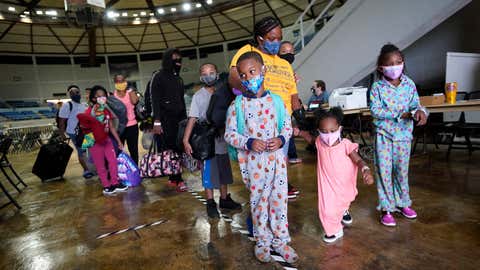
Victoria Nelson with her children Autum Nelson, 2, Shawn Nelson, 7, and Asia Nelson, 6, line up to board a bus to evacuate Lake Charles, Louisiana, on Wednesday, Aug. 26, 2020, ahead of Hurricane Laura.
(AP Photo/Gerald Herbert)
And in places where group shelters did open, strict protocols were in place.
“Even myself – as a worker – I had to get my temperature taken, I needed to make sure that I was wearing a mask, and there was hand sanitizer everywhere,” Gustafson said.
Outbreak at Hurricane Hunters Base
In June, at least five employees at NOAA’s Hurricane Hunters base in Lakeland, Florida, tested positive for COVID-19. While there were no indications the outbreak impacted hurricane forecasting, the pandemic did change the way flights operated.
The number of personnel that would normally fly on the planes, a critical tool in hurricane forecasting, was cut to a minimum. Where once 18 people were on board, including multiple meteorologists and other scientists, engineers, pilots and navigators, that number dropped to nine, with only critical crew members on board, the Orlando Sentinel reported.
(MORE: The 2020 Hurricane Season’s Most Remarkable Moments)
Cleaning of planes was increased and a medical officer monitored the health and wellness of flight crews, NOAA spokesperson Jonathan Shannon told weather.com when the outbreak was reported.
The outbreak was also a stark reminder of how the coronavirus had invaded nearly every part of society, even those critical to helping keep people safe during severe weather.
Weather Models Affected
The sudden drop-off in air traffic as both domestic and international travel came to a screeching halt left computer models lacking in some data that guides day-to-day forecasting.
As part of their routine flying operations, commercial aircraft collect observations of temperature and wind. Many airlines send the data to government weather agencies and other users around the world. More than 800,000 such transmissions were sent in 2017, according to the American Meteorological Society.
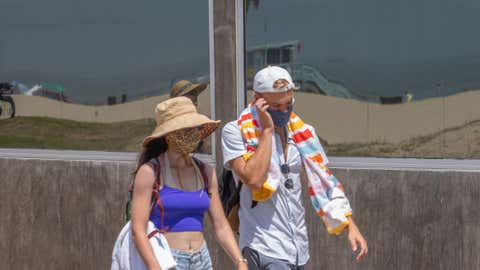
A couple wearing face masks to help stop the spread of coronavirus walks in the boardwalk with the beach reflected in a glass window amid a severe heat wave in Venice, California, on Aug. 15, 2020. The worst heat wave in several years caused rolling blackouts and helped fuel devastating wildfires.
(Apu Gomes/AFP via Getty Images)
By late March of this year, the volume of aircraft weather observations over the U.S. had dropped by more than half. Worldwide, the number had declined 75 to 80{b530a9af8ec2f2e0d4045baab79c5cfb9bfdc23e498df4d376766a0b44d3f146} by May, according to the World Meteorological Organization.
In a report on the impacts of the pandemic, the WMO said many users turned to other technology, such as using more satellites and weather balloons, to fill the data gap left by the drop in air travel.
(MORE: Amid Pandemic, Nonprofits Responding to Hurricanes and Other Disasters Face Volunteer, Funding Shortages)
“The crisis has provided a reminder of the danger of over-reliance on observations of opportunity, such as aircraft-based observations. While these data are unquestionably highly valuable … the COVID crisis has shown that their availability is determined entirely by commercial and operational constraints of the airlines that provide them,” the report said.
It added that, going forward, “it will be crucial to maintain a certain level of investment in core observations” for the specific purpose of weather, climate and the environment.
Critical Climate Research Suspended
As universities shut down and laboratories scaled back, critical climate research was in some cases put on hold. In particular, annual research trips to Antarctica were canceled or shortened.
“It is gut-wrenching,” Nancy Bertler, director of the Antarctic Science Platform in New Zealand, told National Geographic in August. “We only have a few years left to make some very significant changes to avoid the worst of climate change consequences, and we can’t afford to wait a year.”
(PHOTOS: The Most Stunning Damage Aerials of 2020)
While Antarctica has some of the harshest conditions on the planet, the nearly 2.5-mile-thick layer of ice that sits on the continent is a key record of climate change and environmental impacts. Scientists also monitor ice melting, temperatures and other data to track the past and future of global warming.
A few dozen remote research stations scattered across the region support thousands of scientists each year from October through May, which is summertime at the South Pole. Those stations aren’t equipped to deal with coronavirus, nor did researchers want to risk spreading the disease.
Travel restrictions also made it more difficult to go forward with the research season.
Firefighters Battled The Virus, Too
At least 43 cases of COVID-19 were reported among crews battling the Cameron Peak Fire in October, the largest wildfire in Colorado state history. In November, a spokesperson for the National Forest Service told Wildfire Today that more than 200 of the service’s firefighters had tested positive since the start of the pandemic.
The Wildland Fire Lessons Learned Center, which includes a database of reviews and advice from firefighting agencies around the country, has more than 50 reports on how COVID-19 has impacted wildfire response efforts. Many of them detail the successes and failures of maintaining coronavirus protocols while fighting often massive blazes that involve crews from multiple agencies.
(MORE: The Worst Environmental Disasters of 2020)
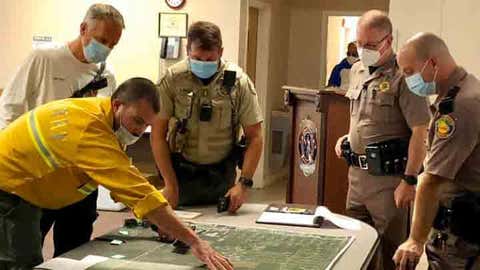
Firefighters and first responders wearing masks to protect against coronavirus as they are briefed on a wildfire in Collier County, Florida, on May 14, 2020.
(Greater Naples Fire Rescue District/Facebook)
The protocols put in place this year included fewer personnel riding in vehicles together; restrictions on where and how they can get food; smaller fire camps; social distancing in gathering areas; temperature checks; and other mitigation measures.
(MORE: Larger Numbers of Backcountry Skiers Expected During Pandemic, Raising Worries Over Avalanche Danger)
But firefighters on the ground say it’s not as easy as it sounds, especially in a community where familylike relationships are the norm.
“People will try and handshake, they will come up on you (close),” Shawn Faiella, superintendent of the Lolo National Forest’s interagency hotshot crew in Montana, wrote in his account of lessons learned during a fire early in the season. “You must be vigilant and tell them to back off. And while this is a great part of fire culture – it’s just not the right time.”
Faiella noted that while coronavirus protocols should be a priority, “It is damn tough to take these practices to the fireline.”
(WATCH: The Weather Stories Our Meteorologists Will Remember From 2020)
As the season exploded into what would be one of the worst in history for several states, firefighter trainings were canceled, work and training were done remotely where possible, departments scrambled to gather PPE and a change in overall operations took place, according to a year-end summary from the wildland fire center.
“Distilling things down, the pandemic provided a general disheveling of our standard operating procedures,” the summary said. “It hasn’t been all good and it hasn’t been all bad.”
Among the challenges: Crews from different areas had different baselines for social distancing and mask-wearing.
The Long, Dark Winter
As we head into the heart of winter, the intersection of coronavirus and weather shows no sign of abating. Health experts correctly predicted that cases would surge in the fall and winter, in part because people tend to gather indoors more in cooler weather.
Agencies that serve the homeless say those who have no place to live are especially at risk from COVID-19. Due to social distancing requirements, the shelters that give them a warm place to sleep when temperatures drop are facing limited capacity.
“The challenge is going to be extreme this winter,” Michael Basford, director of Wisconsin’s Department of Administration’s Interagency Council on Homelessness, told Wisconsin Public Radio.
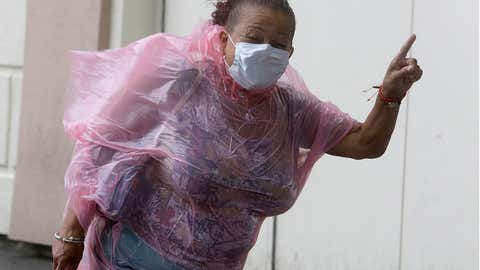
A woman wearing a face mask to help prevent the spread of coronavirus shuts her eyes as she struggles to make her way into the Hard Rock Hotel and Casino during heavy winds, Tuesday, Aug. 4, 2020, in Atlantic City, New Jersey. Tropical Storm Isaias spawned tornadoes and dumped rain during an inland march up the U.S. East Coast after making landfall as a hurricane along the North Carolina coast.
(AP Photo/Jacqueline Larma)
For the latest coronavirus information in your county and a full list of important resources to help you make the smartest decisions regarding the disease, check out our dedicated COVID-19 page.
The Weather Company’s primary journalistic mission is to report on breaking weather news, the environment and the importance of science to our lives. This story does not necessarily represent the position of our parent company, IBM.







